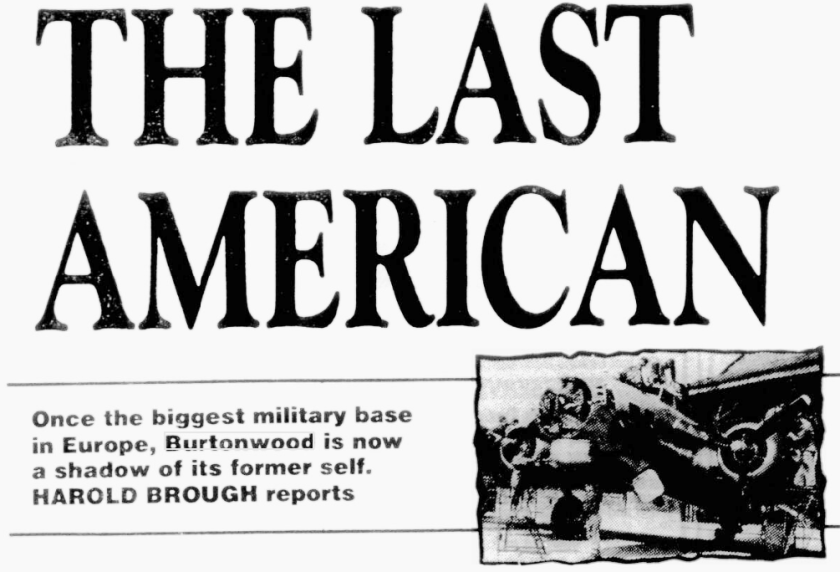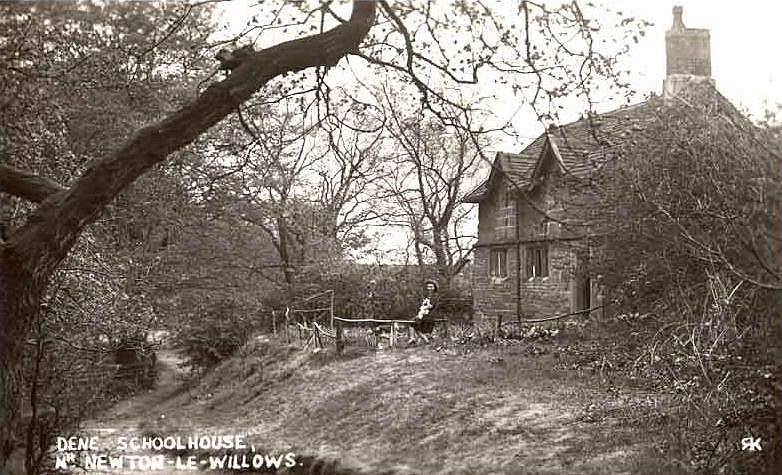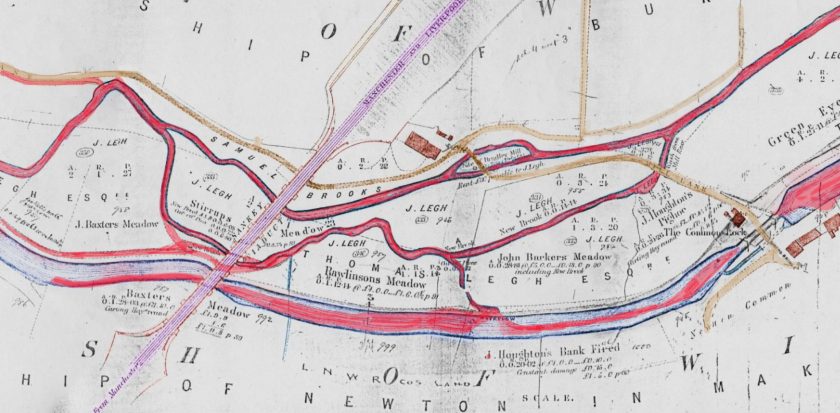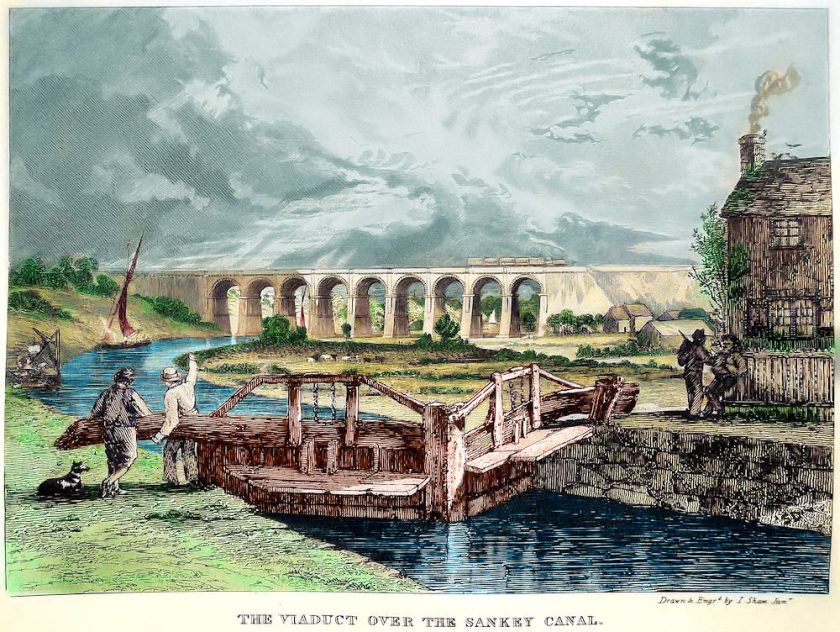Once the biggest military base in Europe, Burtonwood is now a shadow of its former self.
Lieutenant Colonel Bryan C. Lobdell has secured a place in the 50-year-old history of Burtonwood. This spans from the action-packed war years to today, a period marked by the absence of a clear enemy and American budget cuts that are accelerating its decline.
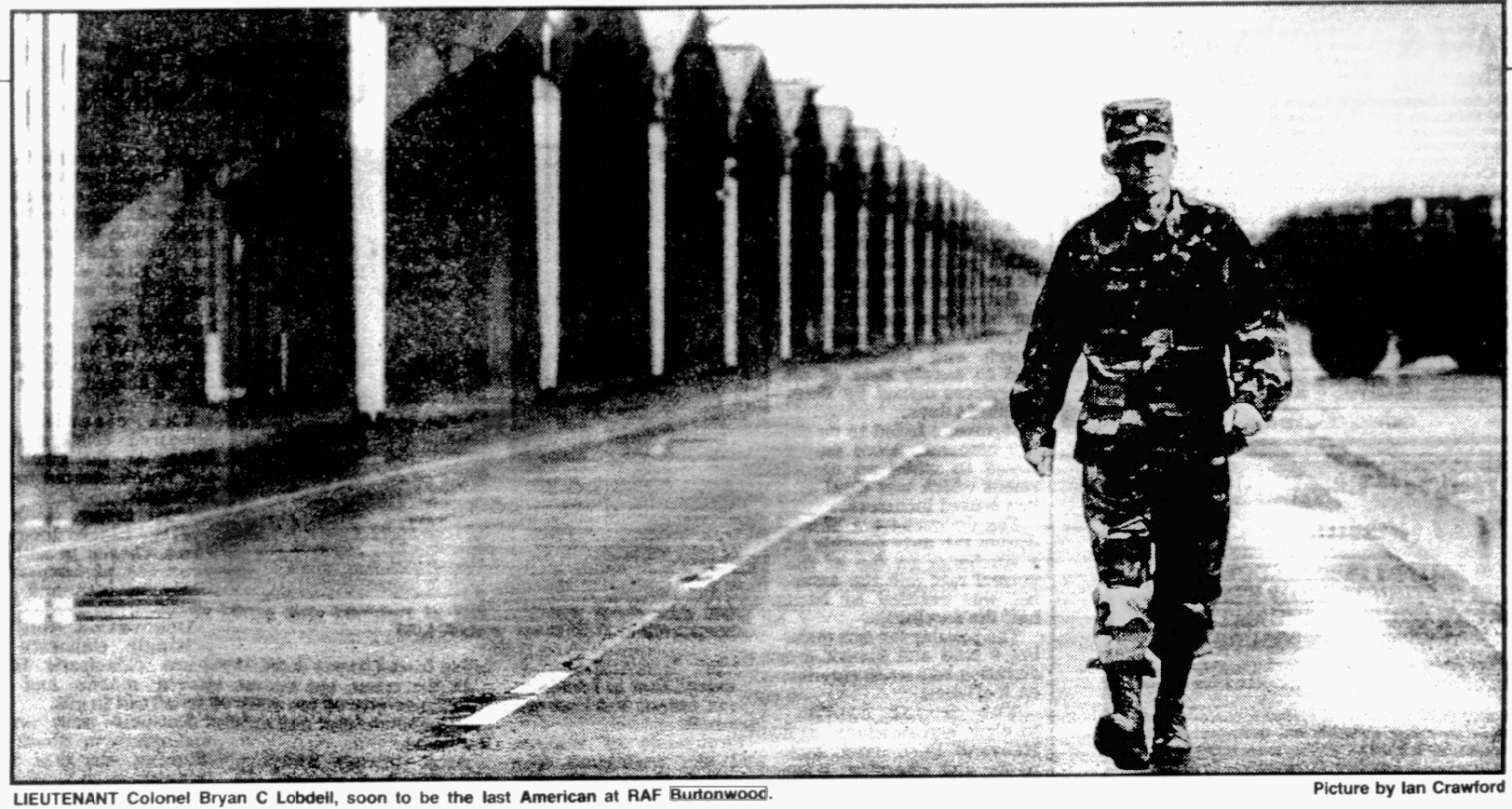
Once, the place resonated with the landings and take-offs of great Flying Fortresses. Men worked in the hangars around the clock, seven days a week, fitting communications and armaments to the mighty bombers, prepping them for the deadly daytime missions against Hitler’s Germany.
Now, the dominant sound at Burtonwood is the hum of the M62.
But during the time it was the largest military base in Europe, many thousands of young Americans lived here. This number reached a peak of 18,500 by the end of the war.
Those who during the war, both foolishly and ungenerously, complained about the Yanks being “overpaid, oversexed, and over here” and scrawled “Yanks Go Home” on street walls saw their wishes fulfilled at Burtonwood. Today, around 15 American servicemen remain, and as the rundown continues, Lt. Col. Lobdell from South Dakota is slated to be the last American in uniform.
Burtonwood serves as the headquarters for the American 47th Area Support Group, which is currently being “deactivated”. As Lobdell explains, “We are rolling up the colors, and they will be sent home to the States.” The 47th’s commanding officer, Colonel Jimmie C. Simpkins, will return to the States with his one-year-old adoptee, Ashley, a Romanian orphan. However, Colonel Lobdell will remain as the commander of the Burtonwood’s Reserve Storage Activity, one of the three depots of the 47th. The other two are located in Southampton, where marine crafts, barges, and floating cranes are stored, and Caerwent in South Wales, a storage facility for ammunition.
Regarding the nature of their storage, Lobdell comments, “Nuclear? I can’t tell you. That goes for both your government and mine.” He suggests, “But go and look at the fence and draw your own conclusions.” He’s a friendly man from South Dakota who joined the Army through the Vietnam draft and chose to stay because it paid better than teaching.
The Americans first came to Burtonwood, near Warrington, for the war and left when it concluded. They returned with the onset of the Cold War and the Berlin Blockade. Their presence at Burtonwood has fluctuated over the years. Wally Barnes, a former Parachute Regiment member and now a charity fundraiser and author, fondly recalls the initial arrivals.
He was 17 and a member of the Home Guard when he saw them from an upstairs window at the Warrington YMCA. These tall men dressed like cowboys and jockeys, with high-heeled boots, some even sporting spurs. Their shirts bore exotic names like Harvard and California. Engaging them in a game of table tennis, he took three home, thus beginning a lifelong friendship with the Americans and a profound interest in Burtonwood.
The sleek American uniforms certainly played a role in sparking many romances, and so did American money. Wally notes that while a British Army private might have earned £4 a month, his American counterpart was pulling in about £29.
Wally reflects on how some local girls were captivated by the Hollywood portrayal of America, enticed by tales of sprawling ranches and opulent lifestyles. He suspects that reality might have disappointed some. However, many of these cross-Atlantic marriages flourished. Some of these once young GIs and their wartime brides will be returning to Burtonwood later this year, reuniting to commemorate the 50th anniversary of the Americans’ arrival.
Veterans might recall a time when as many as 350 B17 bombers were stationed at Burtonwood, with up to 50 landing and taking off within a single day. Today, the majority of the main runway, stretching over one and a half miles, lies beneath the M62 Motorway, though some segments remain visible.
Flight operations from Burtonwood ceased due to issues of mining subsistence. Five wartime hangars, now housing private enterprises, still stand. The Burtonwood Repair Depot also remains, though no longer in military use. Otherwise, those who served here during the war will find scant remnants of that era.
The reason for the continued American presence becomes clear upon entering the warehouses. Two rows of five warehouses, and another two rows of ten stretch out, the view seemingly disappearing nearly half a mile into the distance.
It’s touted as the largest warehouse in Europe. Whether that claim holds water or not, it appears to contain enough equipment to support a third World War.
The Lt. Colonel navigates through the rows, fluently using military jargon and abbreviations. He mentions MREs and POMCUS, then graciously translates: Meals Ready to Eat and Pre-Positioning Of Materials Configurated To Unit Sets.
POMCUS encapsulates every single piece of equipment required to outfit a battalion-sized Army unit, excluding the uniforms and weapons they bear.
The vast storage area comprises 30 warehouses spread over 47 acres. Given its size, some personnel even resort to bicycles for transit within the facility. The range of equipment is so extensive that a dedicated team is constantly inspecting, oiling, de-rusting, and repainting the items.
The inventory is impressive: food, clothing, vehicles, spare parts, parachutes, and sets of 20-foot containers that can be swiftly assembled to create fully-functional, heated, air-conditioned hospitals with a capacity of 1,000 beds. These structures come with integrated operating rooms and X-ray equipment. “Switch on the lights, and you’re set to operate or stitch up, whatever the need may be,” remarks the Lt. Colonel. There are also smaller versions of these medical facilities available.
When the Brits needed immersion heaters for the Falklands War, Burtonwood had them dispatched in a mere 48 hours. Lancashire firefighters, responding to the Armenian earthquake, were provided with arctic gear from this very depot.
The most significant recent mobilization was for the war with Iraq. On a single day, 53 trucks were laden with supplies destined for the front lines.
The shipment consisted of crated hospitals, 62 containers of MREs, 62,000 protective masks, and hundreds of tents, most of which were designated for the Kurds. In total, twelve hundred 40-foot containers were dispatched to support Desert Storm, with another 83 designated for Kurdish assistance. Prior to their departure, the aggregate value of Burtonwood’s supplies approximated £300 million.
Lt. Col. Lobdell won’t find himself completely isolated. While this is RAF Burtonwood, only one uniformed RAF individual remains. However, civilian personnel and security forces will still be present.
The fate of the extensive supplies remains uncertain. With the traditional role of supporting US forces in Europe diminishing, there’s a potential surplus. Changing political dynamics in America, coupled with a potentially shifting stance towards Europe, might lead to decisions to further reduce these stocks. Then again, it might not.
If such a reduction were to happen, it would undoubtedly result in an impressive clearance sale.
(Harold Brough reported the a version of the basic text above in the Daily Post, 29th Feb 1992)
RAF Burtonwood and World War II:
Establishment and Construction: RAF Burtonwood was commissioned in January 1939, initially as a Royal Air Force (RAF) base. The first American personnel arrived in 1942, making it one of the largest U.S. Army Air Forces bases in the UK by the end of the war.
Its primary users throughout its history were the U.S. Army Air Forces (USAAF) and the U.S. Air Force (USAF).
Role as a Maintenance and Repair Depot.
Aircraft Repair: One of the primary roles of Burtonwood was as a maintenance and repair depot. Given the extensive wear-and-tear or battle damage that aircraft sustained, a centralized location was necessary for their refurbishment. Burtonwood was equipped with vast technical and maintenance facilities where entire aircraft could be overhauled.
Supply Depot: It wasn’t just about aircraft repair. Burtonwood became an essential logistics and supply depot for the USAAF. Everything from aircraft parts to personal items for the troops was stored and distributed from here.
Strategic Importance:
With its proximity to the industrial cities of Manchester and Liverpool and excellent rail connections, Burtonwood was strategically placed. Its location was pivotal in receiving, storing, and redistributing essential supplies and equipment to other bases in the UK.
Personnel and Training:
As the war progressed, the base expanded, and by 1945, over 18,000 personnel were stationed at Burtonwood. In addition to the technical and logistical roles, the base also played a part in training personnel, particularly those involved in maintenance and repair tasks.
Cultural and Social Impact:
Given the sheer number of American personnel based at Burtonwood, it became a significant cultural exchange point. GIs introduced British locals to aspects of American culture, from dances like the Jitterbug to American-style diners and snacks. This exchange wasn’t one-sided; American servicemen took home memories of British culture, food, and, in many cases, war brides.
Post-War Role:
After the war, Burtonwood served as a primary demobilization location for American service personnel returning to the United States. Many aircraft returned to the U.S. via Burtonwood, and the base also functioned as a collection point for excess equipment. The base was handed back to the British in 1946 but was leased back to the Americans during the early days of the Cold War in 1948. The onset of the Berlin Airlift made Burtonwood a vital supply and maintenance hub once again.
The role of RAF Burtonwood during the Cold War was multifaceted and closely aligned with the broader geopolitical developments and challenges of the era.
RAF Burtonwood in the Cold War Era.
Reassertion as a U.S. Base:
While the base was returned to the British after WWII, the onset of the Cold War and the evolving nature of the NATO alliance led to the U.S. re-establishing a presence at Burtonwood. The American return in 1948 was primarily driven by the Berlin Blockade and the need to have a logistics and maintenance hub closer to the potential European theater of operations.
Korean War (1950-1953):
While the main theater of the Korean War was in Asia, logistical support and movement of material and personnel often necessitated staging points in Europe. Burtonwood, with its established infrastructure, played a pivotal role in the movement of supplies and troops. While the combat was on another continent, bases like Burtonwood ensured a steady flow of support.
Maintenance and Logistics Hub:
During the Cold War, rapid response and readiness were paramount. Burtonwood’s facilities were continually updated to service and maintain a vast range of equipment. From aircraft parts to ground vehicles, the base ensured that the U.S. European forces had a steady supply of well-maintained equipment.
Cuban Missile Crisis (1962):
During this tense standoff between the U.S. and the Soviet Union, bases across Europe, including Burtonwood, were on high alert. While the crisis centered on the Caribbean, the potential for it to escalate into a broader conflict meant that bases like Burtonwood were essential for rapid response and as a potential staging area.
Intelligence and Surveillance:
While not its primary role, bases like Burtonwood were part of a broader network that gathered intelligence during the Cold War. Given its location and facilities, it’s likely that Burtonwood played some role in processing or supporting intelligence-gathering missions, although specifics might remain classified.
Evolution from Aerial Operations:
As you mentioned, Burtonwood no longer hosted significant flying units during the Cold War. Instead, it transformed into a ground-focused logistics, maintenance, and support hub. This shift ensured that the base remained relevant and critical to the U.S. and NATO strategy in Europe.
Base Housing and American Presence:
Throughout the Cold War, Burtonwood remained a significant American enclave in the UK. Housing complexes, schools, recreational facilities, and even shopping centres were established to support the U.S. personnel and their families. This presence led to a lasting cultural exchange and impact on the local communities.
RAF Burtonwood, while primarily known as a maintenance and logistics base, did host various U.S. Air Force (USAF) squadrons, especially during and immediately after World War II.
Here’s a brief rundown of the significant USAF units and the aircraft types they operated:
315th Troop Carrier Group:
Timeframe: During World War II.
Aircraft: Primarily the C-47 Skytrain.
53rd Troop Carrier Squadron:
Timeframe: After World War II.
Aircraft: Primarily the C-54 Skymaster.
59th Air Depot Wing:
Timeframe: Post-World War II era.
Aircraft: While this unit was primarily responsible for maintenance and depot-level repair, it would have overseen a variety of aircraft types that came in for repair and overhaul. This would include fighters, bombers, and transports from the wartime era, such as the P-51 Mustang, B-17 Flying Fortress, and others.
While these were the primary USAF units stationed at Burtonwood for specific periods, the base saw a wide variety of aircraft come and go, especially given its role as a maintenance and logistics hub. Over its operational lifespan, many different aircraft types would have passed through for repairs, maintenance, or transitory reasons.
In the later Cold War period, while the base was primarily used for logistics and wasn’t home to specific flying units, it would have still seen various aircraft types, especially transport and cargo aircraft like the C-130 Hercules, using the facility for logistics, cargo movement, and personnel transit.
Overall, during the Cold War, RAF Burtonwood adapted to the changing strategic needs of the period, reinforcing its importance not just as an air base but as a crucial logistical and support facility for U.S. and NATO operations in Europe.
